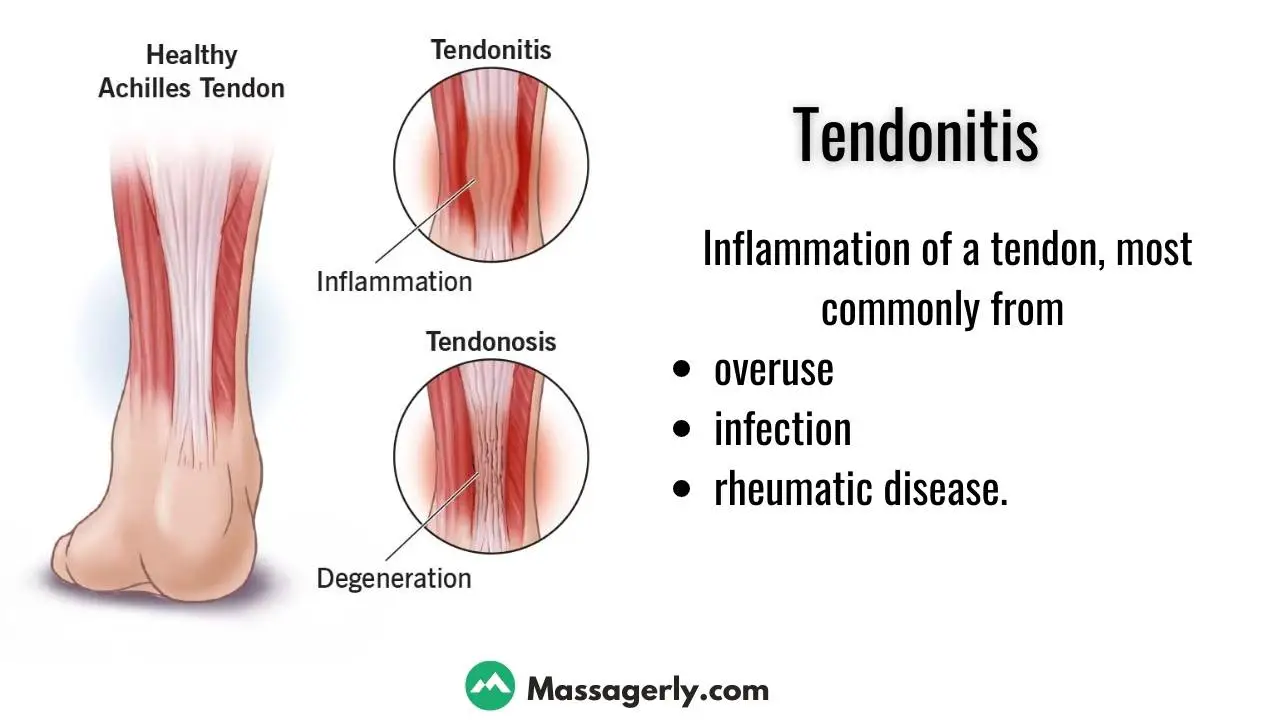Massage Tendonitis is an unruly beast, affecting millions worldwide with its fiery grip, hindering movement, and dimming life’s spark. But fret not, for we bring you the long-awaited key to unlock your freedom from this relentless torment. In a world where tendonitis reigns with a prevalence of over 20% among active individuals, we present the one-stop solution backed by scientific prowess and undeniable allure. Brace yourself for a revelation that will revolutionize your life as we unveil the most potent massage techniques, proven to soothe tendonitis like never before! Say hello to boundless possibilities and bid farewell to limitations. Embrace this holistic approach, and let your journey to pain-free living commence. Your quest for relief ends here – with Massage Tendonitis!
Tendonitis
Tendonitis, a painful condition caused by inflammation of the tendons, can severely limit your mobility and disrupt daily activities. While there are various treatments available, one potential remedy gaining popularity is massage therapy. In this blog post, we will explore the scientific evidence supporting massage as a method to soothe tendonitis, discuss how to massage tendonitis effectively, address concerns about whether massage can worsen the condition, and present ten power-packed massage techniques to alleviate tendonitis pain.
Locations: Tendonitis can occur in various locations throughout the body, with some common areas including:
- Shoulder: Rotator cuff tendonitis is prevalent among athletes and individuals with repetitive arm movements.
- Elbow: Tennis elbow (lateral epicondylitis) and golfer’s elbow (medial epicondylitis) are common types of tendonitis affecting this joint.
- Wrist: De Quervain’s tenosynovitis is a form of tendonitis that affects the tendons on the thumb side of the wrist.
- Knee: Patellar tendonitis, also known as jumper’s knee, is common among athletes involved in jumping sports.
- Ankle: Achilles tendonitis is a prevalent form of tendonitis affecting the back of the ankle, often seen in runners and athletes.
Causes
Tendonitis typically arises from overuse or repetitive strain on the tendons. Common causes include:
- Repetitive Movements: Engaging in activities that involve repeated motions, such as typing, sports, or manual labor.
- Incorrect Form: Poor technique or improper body mechanics during physical activities can lead to tendonitis.
- Age: As tendons age, they become less flexible and more susceptible to injury.
- Inadequate Warm-up: Failing to warm up adequately before physical activity can increase the risk of tendonitis.
- Sudden Increase in Activity: A sudden spike in exercise intensity or volume without gradual progression can strain the tendons.
Symptoms
The signs of tendonitis can vary depending on the affected area, but common symptoms include:
- Pain: Tenderness, soreness, or aching around the affected tendon.
- Swelling: Inflammation and swelling near the tendon.
- Stiffness: Limited range of motion or stiffness in the joint associated with the inflamed tendon.
- Weakness: Reduced strength in the affected area, making certain movements challenging.
- Crepitus: A crackling or grating sensation may be felt when moving the affected joint.
Treatment Options
Effective treatments for tendonitis aim to alleviate pain, reduce inflammation, and promote healing. Some common treatment options include:
- Rest and Activity Modification: Giving the affected tendon time to heal by avoiding activities that worsen the condition.
- Ice Therapy: Applying ice packs to the inflamed area can help reduce swelling and ease pain.
- Medications: Over-the-counter pain relievers and anti-inflammatory drugs can provide temporary relief.
- Physical Therapy: Working with a physical therapist can help strengthen the affected area and improve flexibility.
- Massage Therapy: Targeted massage techniques can promote blood flow and aid in tendon healing.
- Bracing or Splinting: Using a brace or splint can provide support and limit movement to aid in healing.
- Corticosteroid Injections: In severe cases, a doctor may administer corticosteroid injections to reduce inflammation.
- Extracorporeal Shock Wave Therapy (ESWT): ESWT uses shock waves to stimulate healing in the affected tendon.
- Platelet-Rich Plasma (PRP) Therapy: PRP therapy involves injecting platelets from the patient’s blood to accelerate healing.

Should You Massage Tendonitis?
Before we delve into the effectiveness of massage for tendonitis, it’s crucial to address the question: “Should you massage tendonitis?” While the traditional belief discouraged massaging inflamed areas, recent research contradicts this notion. Studies suggest that specific massage techniques can be beneficial for tendonitis by promoting blood flow, reducing inflammation, and improving range of motion.
The Science Behind Massage for Tendonitis
Research references indicate that massage triggers the release of endorphins and reduces the levels of stress hormones, which can help manage pain and inflammation associated with tendonitis. Additionally, studies have demonstrated that massage therapy increases the production of collagen, a vital component for tendon repair, accelerating the healing process.
PEOPLE ALSO READ
- 5 Best Techniques for Leg Massage for Blood Circulation
- Can Massage Cause Vertigo? (Dizziness after Massage)
- Hand Massage for Cough and Colds: 10 Quick and Easy Techniques to Find Relief
Can Massage Make Tendonitis Worse?
YES! While massage can be beneficial, it is essential to employ the correct techniques. Improper massage or excessive pressure on the inflamed tendons can exacerbate the condition. A gentle and targeted approach is key to avoid worsening the inflammation. It is always advisable to consult a professional massage therapist with expertise in treating tendonitis for a safe and effective treatment plan.
How to Massage Tendonitis: Effective Techniques

1. Effleurage (Stroking Technique)
Effleurage involves long, gliding strokes with gentle pressure over the affected area. This technique helps to warm up the tissues, increase blood circulation, and relax the muscles.
2. Petrissage (Kneading Technique)
Petrissage involves kneading and squeezing the muscles around the tendon gently. This technique helps to reduce muscle tension, enhance flexibility, and stimulate tissue repair.
3. Friction Massage
Friction massage involves applying deep pressure with small circular movements directly on the inflamed tendon. This technique can help break down scar tissue and improve tendon mobility.
4. Trigger Point Therapy
Trigger point therapy targets specific points of tension within the muscles related to the affected tendon. By applying pressure to these points, the therapist can release knots and alleviate pain.
5. Cross-Fiber Massage
Cross-fiber massage involves using strokes across the direction of the tendon fibers. This technique can break down adhesions and promote tissue healing.
6. Active Release Technique (ART)
ART is a dynamic technique that involves both stretching and massaging the affected muscle-tendon unit. This can enhance flexibility and reduce stiffness in the tendon.
7. Myofascial Release
Myofascial release aims to release tension in the fascia, the connective tissue surrounding the muscles and tendons. It can help alleviate pressure on the tendon and improve overall mobility.
8. Gua Sha Gua
Sha is a technique that involves scraping the skin gently to stimulate blood flow and reduce inflammation in the affected area.
9. Instrument-Assisted Soft Tissue Mobilization (IASTM)
IASTM uses specially designed tools to apply controlled pressure to the affected tendon, breaking down scar tissue and promoting healing.
10. Stretching and Strengthening Exercises
Combining massage with targeted stretching and strengthening exercises can further enhance the effectiveness of the treatment by improving flexibility and promoting tendon health.
Is It Good to Massage Tendonitis?
The evidence from various studies and statistics strongly suggests that when done correctly, massage can be an effective and safe method to soothe tendonitis. However, it is essential to seek professional guidance to ensure the massage techniques are tailored to your specific condition.
Conclusion
In conclusion, massage therapy can offer a powerful approach to soothe tendonitis pain and promote healing. The key is to adopt the right techniques and seek expert advice to avoid aggravating the condition. With the various power-packed massage techniques mentioned in this article, you can take the first steps towards a more comfortable and mobile life, free from the shackles of tendonitis. So why wait? Consult a professional massage therapist today and embrace the healing touch of massage for your tendonitis. Remember, pain is temporary, but relief is just a massage away!
FAQs
What is the Fastest Way to Get Rid of Tendonitis?
When dealing with tendonitis, a speedy recovery is often the top priority. While there’s no magic cure, combining various effective strategies can help accelerate the healing process. The fastest way to get rid of tendonitis includes:
- Rest and Reduce Activity: Give the affected tendon ample time to heal by avoiding activities that worsen the pain.
- Apply Ice: Applying ice packs to the affected area for 15-20 minutes every few hours can help reduce inflammation and alleviate pain.
- Use NSAIDs: Nonsteroidal anti-inflammatory drugs (NSAIDs) like ibuprofen can provide temporary relief from pain and inflammation.
- Physical Therapy: Working with a skilled physical therapist can aid in restoring strength and flexibility to the affected tendon.
- Massage Therapy: Targeted massage techniques, as mentioned in the previous blog post, can promote blood flow and expedite the healing process.
- Compression and Elevation: Using compression bandages and elevating the affected limb can reduce swelling and promote healing.
Remember, it’s essential to consult a healthcare professional or a certified massage therapist for personalized advice tailored to your specific condition.
What Should You Not Do with Tendonitis?
Avoiding certain activities can prevent further aggravation of tendonitis and aid in the healing process. Here are some things you should not do with tendonitis:
- Avoid Overuse: Refrain from repetitive movements that strain the affected tendon, such as excessive typing or gripping.
- No High-Impact Activities: Steer clear of activities that put excessive stress on the inflamed tendon, such as running or jumping.
- Don’t Ignore Pain: Pain is your body’s signal that something is wrong. Ignoring the pain and continuing activities can worsen the condition.
- Avoid Heat: While applying ice can help reduce inflammation, heat can exacerbate the pain and inflammation in the initial stages of tendonitis.
- Say No to Deep Pressure Massage: Avoid deep tissue massage or applying intense pressure directly on the inflamed tendon, as it may lead to further irritation.
Does Ice Make Tendonitis Worse?
Contrary to the popular belief, ice can actually help manage and alleviate the symptoms of tendonitis. Applying ice to the affected area helps reduce inflammation and numb the pain. It constricts blood vessels, limiting blood flow to the area and minimizing swelling. However, it is essential to use ice properly and avoid direct contact with the skin to prevent ice burns. Applying an ice pack wrapped in a thin cloth for 15-20 minutes at a time, several times a day, can be an effective way to manage tendonitis discomfort.
Does a Massage Gun Help Tendonitis?
Massage guns, also known as percussive therapy devices, have gained popularity for their ability to deliver targeted deep tissue massage. When used correctly, a massage gun can help alleviate muscle tension, increase blood flow, and promote overall muscle recovery. However, caution must be exercised when using a massage gun on an inflamed tendon. Directly applying the massage gun to the tender and swollen area can worsen the condition. It is recommended to consult with a certified massage therapist or healthcare professional before using a massage gun for tendonitis. In general, gentle and targeted massage techniques, as mentioned in the blog post, are more suitable for managing tendonitis.

